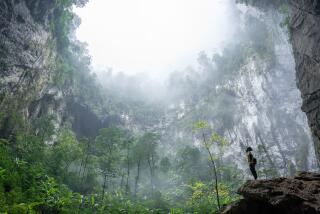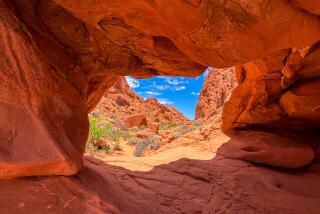A Couple of Cave Women on Taking an Amazing ‘Journey’
- Share via
Dr. Hazel Barton is a British biologist who travels the world collecting samples of rare microorganisms for use in scientific and medical research. Serious business when one considers the objects of her affections and the samples for her test tubes and petri dishes come from volcanoes at the bottom of the Pacific Ocean and from deep inside the hot springs at Yellowstone Park.
Cast along with educator-caver Nancy Aulenbach from Atlanta as one of the two leading figures in MacGillivray Freeman Films’ latest large-format documentary, “Journey Into Amazing Caves,” one might expect an antiseptic atmosphere to reign when speaking to these two women about their participation in the film.
But, as the speakerphone clicks on at an office inside the Cleveland Science Center, the first thing out of Barton’s mouth is more like a commercial for Miller Lite.
“Whazzup!” Barton blurts in greeting, followed by giggling from the pair and an introduction by producer Greg MacGillivray. Clearly, the women, members of the National Speleological Society, a 12,000-strong organization of enthusiasts who come together in the interest of cave conservation and science, enjoy each other’s company.
Good thing, because over the course of three years spent making director Steve Judson’s $4-million film, Barton and Aulenbach have been cooped up together in tents pitched on the Arctic permafrost, dangling from ropes 500 feet beneath the surface of Greenland ice caves, rappelling from cliffs in the Grand Canyon and diving together in cramped, pitch-black waterways inside sea caves in Mexico’s Yucatan.
“We are both cavers,” explains Barton, who will marry this October in Glenwood Caverns in Colorado, with Aulenbach, dressed in pink caving gear, as her bridesmaid. “We’ve become like sisters especially after the weird experience of being involved in a project like this. We’ve gone though a big learning process together.”
In a separate interview conducted in the projection booth at the California Science Center, Judson, who has moved up to the director’s chair after co-directing “Everest” and “Stormchasers” and editing every MacGillivray Freeman release in the last 18 years save for “Wild California,” says he choose Barton and Aulenbach because “we had trouble deciding between the two. Hazel brings a complex and scientific component to the film. And Nancy [a teacher’s assistant at the Northwoods Montessori school in Atlanta] is the person who brings the emotional connection. She is the person who makes you love caves.”
The film seamlessly integrates adventurous storytelling with a solid educational component that, as Judson says, “comes with the territory when you have Nancy on the team. Greg and I are very committed to making films that work for the institutional theaters and the museums. We try to make them as entertaining as possible with the hope that they will play in [commercial] theaters as well.”
Because she was frequently out of the classroom during the filming, a Web site was established via a satellite telephone hookup to keep Aulenbach in touch with her students (https://www.nancy4caves.net). And at several junctures in the film we see this interactive process carried out with on-screen students receiving lessons from remote locations in Greenland and Mexico.
“I think the great thing about this movie is that it gives kids an opportunity to see that science can be a fairly interesting career. When I grew up,” Barton says, “the image of scientists were as boring people who went about wearing protective goggles and white lab coats. Now we have kids coming up to us saying ‘Wow! I want to be a scientist.’ ”
Locations Key in Shaping Movie
The film does make a career in science look alluring, as it visits some of the most beautifully exotic locations on the planet, places that most people will never be able to experience firsthand because of their remoteness and the advanced survival skills required.
“Choosing locations was the key thing in shaping this movie. One thing we wanted to avoid was making a large-screen version of the typical TV documentary on limestone caves.
“A lot of people have visited the Mammoth and Carlsbad caverns, but hardly anyone has been in an ice cave or an underwater cave,” Judson says.
“Greg urged me to think in terms of color. To choose locations that would provide different colors and not make people sit in the dark for 38 minutes. And the ice caves in Greenland are the most spectacularly blue places I’ve ever been.
“Our guide, Janot Lamberton [seen in the film and in the National Geographic companion book ‘Caves Exploring Hidden Realms’ by Michael Ray Taylor] spoke about them possessing a spiritual quality. But it wasn’t until the first time I dropped into one that I understood his words. Once inside, I could feel in my bones what he was talking about. It was spectacularly peaceful. Unlike anything else. You feel like you have gone back in time.”
Aulenbach concurs: “You hear about things that are iridescent blue. But this was beyond anything I could have imagined. The whole cave was glowing.”
Along with beauty comes a danger that is just as overwhelming. When asked to compare the risks in sending climbers and camera crew into the ice with those encountered while filming “Everest,” where he was headquartered at the base camp in Nepal, Judson declares them equal.
“It’s a hairy environment inside the caves. Climbers like to be attached to a wall that they know isn’t going anywhere. We had to attach our rigs to the sheer vertical walls of the caves in order to set platforms for the camera crew and the tripod. Often these surfaces are huge blocks of ice weighing tons and tons and they can sheer off. This happened while the crew was there. All of the sudden one of the platforms shifted and the cameramen thought it was going to break loose,” Judson recounts. “But it didn’t actually break away.”
For Barton, the most exciting part of the experience was collecting samples of an extremophiles group (microorganisms that use unique strategies for survival in extreme environments) called Haloclines that exist in gelatinous pools where freshwater meets saltwater in the underwater caves in the Yucatan.
Using English slang, Barton refers to these undocumented creatures as “boogers,” which she brings back to her laboratory to clone and to sequence the DNA. Processing samples from a one-week trip can take up to six months of lab time, Barton says.
The biggest challenge for Aulenbach was rappelling off of 300-foot cliffs in the Grand Canyon, then swinging by rope into a cave entrance. Not really risky, she says, if you know what you are doing. Having risen to prominence in the male-dominated sport of caving, Barton and Aulenbach still can’t believe their good luck at having been cast in the film.
“Without the film company, it would have been very difficult to get to the upper regions of the Grand Canyon. It would have been very difficult,” Aulenbach says, “for us to hire a private helicopter to take us 60 miles out onto the icecaps of Greenland.”
Barton is used to paying her own way.
“When I returned to Greenland to collect more samples, I ran up some pretty good credit card bills buying tickets and extra equipment. We do this for the love of caving and we do it for science. If I wanted to make money I would not be a biologist. And I certainly wouldn’t be a caver.”
More to Read
Only good movies
Get the Indie Focus newsletter, Mark Olsen's weekly guide to the world of cinema.
You may occasionally receive promotional content from the Los Angeles Times.










